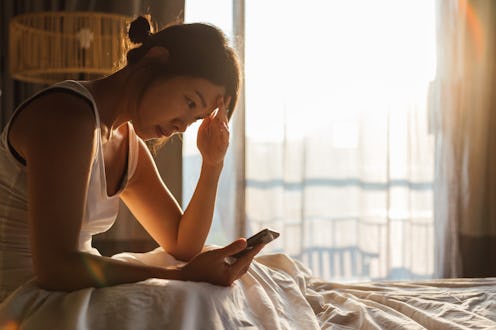Life
Social Distancing Is A “Perfect Storm For Headaches,” Doctors Say

If your head keeps feeling like it's housing a clog-dancing convention and you're constantly running out of Tylenol, you're not alone. Experts say that for people who are prone to headaches, the stress caused by coronavirus — from the pressures of social distancing to money worries — is likely to trigger pretty bad episodes right now. A combination of stress, screen time, and confinement inside are responsible.
"People are using computers and smart phones constantly during these shuttered pandemic days, whether that be for work or pleasure," Dr. Lori Russell-Chapin, Ph.D., co-director of the Center for Collaborative Brain Research at Bradley University, tells Bustle.. If you're going from remote working to a Zoom hangout with friends to a marathon session of Candy Crush and some Netflix, your overall time in front of a screen may add up to 10 hours or more a day.
Lots of exposure to screens can hurt your head, in part because it strains your eyes, Dr. Howard Krauss M.D., a surgical neuro-ophthamologist, tells Bustle. "In our desire to keep watching or reading, we struggle to keep the eyes open and keep focusing, until we end up with eye aches and a headache," he says. A study published in BMJ Open Ophthalmology in 2018 found that headaches were one of the most common symptoms of digital eye strain.
Sitting extra — as happens when you're not really allowed to leave the house except for essentials — can be a trigger for head pain on its own. "Prolonged screen time may provoke poor posture or sustained head, neck and shoulder positions, which may cause neck and head aches," Dr. Krauss tells Bustle.
Your run-of-the-mill tension headaches haven't gone away, either. "It's a perfect storm for headaches," Dr. Gregory Nawalanic M.D, a clinical psychologist with the University of Kansas Health System, tells Bustle. "Facing financial strains and juggling the demands of family, in a world where routine errands have become daring missions, could cause anyone to develop a stress headache." He says a combination of stressors, including working from home, home-schooling kids, upticks in screen time, and relationship strain might all contribute to head pain. "The backdrop of stress and uncertainty fuels the headache factory."
Stress often causes migraines and other headaches through the contraction of muscles, often in the neck or shoulders; a study published in The Journal Of Headache & Pain in 2017 found that 80% of people with migraines found stressful situations to be a trigger. But being anxious can make your head hurt even if your muscles are as relaxed as a sleeping cat's. Research shows that these kinds of pains can be triggered by lack of sleep, depression, and emotional upheaval, all of which are pretty common right now.
If you're over having a headache 24 hours a day, Dr. Russell-Chapin suggests making sure you drink water frequently, and taking breaks from screens whenever you can, doing some movement and stretching your neck and shoulders. "Most Americans are struggling to find the time to breathe, yet alone carve out time to meditate or exercise," Dr. Nawalanic says. "That said, it's more important than ever," he says. Whatever lowers your stress levels — a bubble bath, a kickboxing session in your living room, a phone chat with some friends — might also help your headaches.
Experts:
Dr. Howard Krauss M.D., surgical neuro-ophthamologist
Dr. Gregory Nawalanic M.D, clinical psychologist
Dr. Lori Russell-Chapin Ph.D., professor
Studies cited:
Moon, H., Seo, J. & Park, S. (2017) Perceived stress in patients with migraine: a case-control study. J Headache Pain 18, 73. https://doi.org/10.1186/s10194-017-0780-8
Sheppard, A.L., Wolffsohn, J.S. (2018) Digital eye strain: prevalence, measurement and amelioration BMJ Open Ophthalmology 3. e000146. doi: 10.1136/bmjophth-2018-000146
This article was originally published on